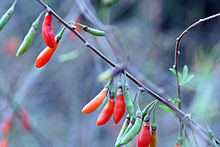Chinese wolfberry
| Chinese wolfberry | ||||||||||||
|---|---|---|---|---|---|---|---|---|---|---|---|---|

Chinese wolfberry ( Lycium chinense ) |
||||||||||||
| Systematics | ||||||||||||
|
||||||||||||
| Scientific name | ||||||||||||
| Lycium chinense | ||||||||||||
| Mill. |
The Chinese wolfberries ( Lycium chinense ) is a plant from the genus of Lycium ( Lycium ) within the family of the nightshade family (Solanaceae). It is widespread in Eurasia .
description
The Chinese wolfberry, called gǒuqǐ ( Chinese 枸杞 ) in China , grows as an independently upright or climbing, thorny shrub and reaches heights of 0.5 to 1 meters. The leaves are 15 to 50 mm long and 5 to 25 mm wide.
The flowers are hermaphroditic with a double flower envelope . The calyx is bell-shaped and hairy ciliate. The calyx tube has a length of 3 to 4 mm. The purple-colored petals are fused into a 9 to 12 mm long corolla tube and the corolla lobes are shorter or almost the same length.
The red berries when ripe are ovate or elongated with a length of 7 to 15 mm and a width of 5 to 8 mm and contain a large number of seeds .
The number of chromosomes is 2n = 24, 36 or 48.
Occurrence
The Chinese wolfberry is widespread from Europe to Southwest Asia and from Pakistan to Nepal and China to Korea , Taiwan and Japan . He is a naturalized neophyte in Germany .
Systematics
Lycium chinense was first published by Philip Miller . The specific epithet chinense refers to the origin from China.
Within the species Chinese wolfberry ( Lycium chinense ) two varieties are distinguished:
- Lycium chinense Mill. Var. Chinense
- Lycium chinense var. Potaninii (Pojarkova) AMLu
Molecular biological studies confirm a strongly supported clade , which, in addition to Lycium chinense, consists of the common wolfberry ( Lycium barbarum ) and Lycium ruthenicum . However, the relationship of the three species to other ancient world species has not been clearly established.
use
The berries of the Chinese wolfberry are known as wolfberries or goji berries along with those of the common wolfberry ( Lycium barbarum ) . Some of the sour-bitter berries are added unprocessed to the usual green tea . In Chinese medicine, they are considered to be good for eyesight.
literature
- JS Miller and RA Levin: Lycium chinense . In: Project Lycieae
- Rachel A. Levin et al .: Evolutionary Relationships in Tribe Lycieae (Solanaceae). In: DM Spooner, L. Bohs, J. Giovannoni, RG Olmstead, D. Shibata (eds.): Solanaceae VI: Genomics meets biodiversity. Proceedings of the Sixth International Solanaceae Conference. ISHS Acta Horticulturae 745, June 2007, ISBN 978-9066054271 , pp. 225-239.
- Lycium chinense in the Flora of China, Vol. 17.
Web links
- Chinese wolfberry. In: FloraWeb.de.
- Chinese wolfberry . In: BiolFlor, the database of biological-ecological characteristics of the flora of Germany.
- Lycium chinense Mill. In: Info Flora , the national data and information center for Swiss flora . Retrieved February 28, 2016.
- Thomas Meyer: Buckthorn data sheet with identification key and photos at Flora-de: Flora von Deutschland (old name of the website: Flowers in Swabia )
- Data sheet with photos.
- Lycium chinense at Useful Tropical Plants, accessed March 31, 2018.
Individual evidence
- ↑ term "gouqi (枸杞) - Lycium chinense Miller, Gard", Chinese / English: [1] on efloras.org, accessed on May 29, 2018 - Online
- ^ Erich Oberdorfer : Plant-sociological excursion flora for Germany and neighboring areas . With the collaboration of Angelika Schwabe and Theo Müller. 8th, heavily revised and expanded edition. Eugen Ulmer, Stuttgart (Hohenheim) 2001, ISBN 3-8001-3131-5 , pp. 819 .
- ↑ Lycium chinense at Tropicos.org. In: IPCN Chromosome Reports . Missouri Botanical Garden, St. Louis
- ↑ Lycium chinense / barbarum - Goji berry at Karlsruhe Institute of Technology, accessed on November 3, 2017.
- ↑ Helmut Pirc: Encyclopedia of wild fruit and rare fruit species. Leopold Stocker Verlag, 2015, ISBN 978-3-7020-1635-7 .



